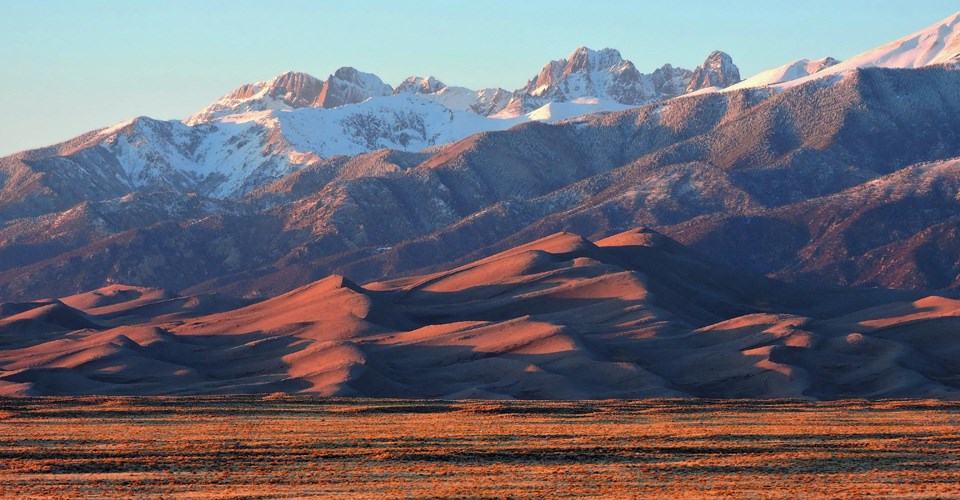Managing natural areas in a changing climate
Land managers need site-specific information about the vulnerability of plants and animals to climate change. The most common way to measure climate is through air temperature and precipitation. However, these two variables alone don’t account for many important aspects of climate that affect plants and animals. For example, water can be stored temporarily (as snow or in the soil), some runs off, and some evaporates. Local conditions like soil, slope, and slope aspect (the compass direction the slope is facing) modify the timing and abundance of water in soil. One way to better predict climate effects is to estimate how water availability—not just total precipitation—affects plants and animals. This approach uses a concept called water balance.
What is water balance?
Water balance is like a checking account for water. It tracks water input and output as well as the different forms it can take as liquid, solid, and gas. Whether precipitation falls as rain or snow depends on the temperature. How much water is stored in soil or how much runs off depends on soil properties. The duration of time when soil is moist enough for plant growth depends on temperature as well as the topographic setting on a north or south facing hillside. After snow melts, warm temperature returns some moisture to the atmosphere through evapotranspiration. As the growing season progresses, soils dry, unless it rains (like a deposit into a checking account). This means that over the course of a dry summer, plants may have less access to water than they need, a condition called water deficit. Water deficit is an important measure of water balance as it strongly affects vegetation health.How is water balance used?
A water balance model derives many variables from temperature and precipitation that are important to plants and animals. These variables include soil moisture, evapotranspiration, runoff, water deficit, and more. Compared to temperature and precipitation, these variables are usually better at predicting how plants and animals respond. This is because they are better estimates of the conditions plants and animals actually experience. For example, not all precipitation is available to plants, as some runs off to provide habitat for fish and frogs. Also, plants don’t use rain directly—they take moisture from soil.A case study in Great Sand Dunes National Park and Preserve applied a water balance model to plant growth in response to climate. The results showed that plants at higher elevations in the park had plenty of moisture but not much warmth—they tended to be temperature limited and warmer temperatures significantly boosted their growth. Conversely, lower elevation plants had sufficient warmth but not always enough moisture—they tended to be water limited and moisture from snowfall accelerated their growth. Park managers can use these results to track different aspects of climate if they are curious about climate impacts in different areas of the park.

NPS/Patrick Myers
The value of water balance
Including water balance in our models of climate impacts on park resources is a step closer to understanding the process of water use by plants and animals, both aquatic and terrestrial. This improved understanding translates to better predictions of how park resources may fare in the future as the climate changes. Better understanding and predictions mean park managers may be able to prevent some undesirable effects of climate change or may be able to use restoration to undo damage that has already occurred.
Water balance has several added benefits:
- It is broadly applicable. A growing collection of research and case studies apply water balance to varying resources, from spring and stream flow to plant and animal responses. See the published studies below.
- It is readily accessible. This approach uses commonly available climate data and a water balance model that translates temperature and precipitation into more ecologically relevant measures of water availability.
- It supports Climate Smart Conservation. Water balance modeling feeds directly into an internationally used planning framework known as Climate Smart Conservation. It provides quantitative measures of climate exposure and sensitivity needed to understand how vulnerable resources are to climate change.
Water balance studies in national parks
Below you’ll find studies describing the use of water balance for understanding and managing climate impacts in national parks. They show a variety of ways that water balance can be used to help land managers predict and respond to the effects of climate change on natural resources in their care. Click on the Publications tab to view the full studies. Click on the Printable Briefs tab to view a mix of study summaries, where available, and other water balance content. Browse the Web Briefs and Articles to view a mix of study summaries, where available, and other water balance content in HTML format.Source: Data Store Collection 7928. To search for additional information, visit the Data Store.
Source: Data Store Collection 7929. To search for additional information, visit the Data Store.
Web briefs and articles
Learn more
To learn more about water balance and climate change adaptation, including additional research, contact:David Thoma, Ecologist
Greater Yellowstone Inventory and Monitoring Network
Billy Schweiger, Ecologist
Rocky Mountain Inventory and Monitoring Network
John Gross, Ecologist
Climate Change Response Program
*Figure adapted from Gray, S. T., and G. J. McCabe. 2010. A combined water balance and tree ring approach to understanding the potential hydrologic effects of climate change in the central Rocky Mountain region. Water Resources Research 46(5).
Last updated: January 13, 2025
